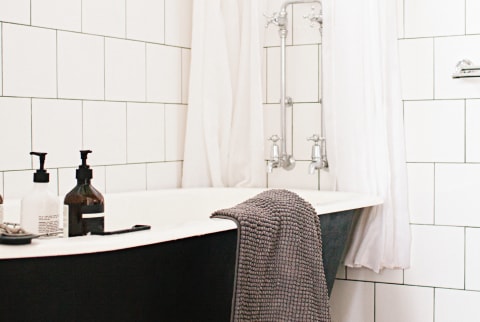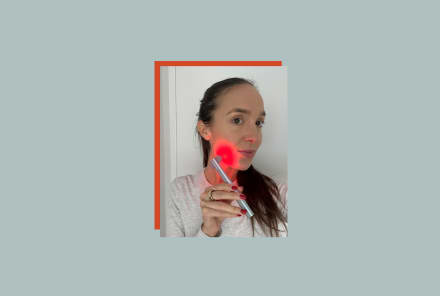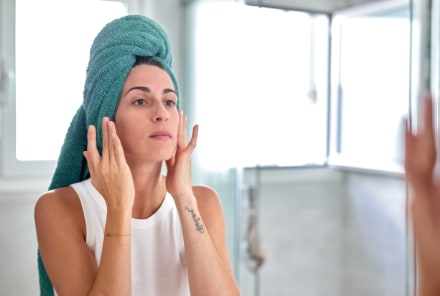Advertisement
Why It Might Be Time To Swap Out Your Shower Curtain + 6 Better Options


Shower curtains/ liners are one of those things that we use all the time (at least once a day, hopefully!) and hardly ever think about. But this overlooked bathroom fixture has actually been associated with some pretty nasty stuff over the years. Here's what you should look out for when you're in the market for a new one.
The one thing that should never be in your shower curtain: PVC.
PVC—or polyvinyl chloride—is a type of plastic used in vinyl flooring, insulation, and, you guessed it, shower curtains and liners. It's strong but also flexible.
Serious doubts about the widely used material started to surface over a decade ago, when people complained of headaches and dizziness after smelling the pungently chemical odor of their new PVC shower curtains.
These complaints are part of what prompted Mike Schade and his team at The Center for Health, Environment & Justice to investigate what exactly was going on. Back in 2008, they set out to buy five different curtains, test them for certain chemicals, and study if and how these chemicals made their way into the surrounding air over the course of 28 days.
"We found that one new curtain on its own can release over 100 chemicals into indoor air, some of them persisting in the air for at least 28 days," Schade, who is now a campaign director at Safer Chemicals, Healthy Families, tells mbg.
The shower curtains had low levels of chemicals associated with everything from endocrine disruption1 to respiratory issues. All of them also contained phthalates: hormone disrupters that are known to linger in the environment.
The 2008 study only tested how the shower curtains affected the surrounding air when dry—not when exposed to hot, humid temperatures like they would be in an actual shower. Schade predicts that these conditions could only stir up more toxicity.
"I think there's a very good chance that vinyl shower curtains—even after you've had one in your home for months—continue to off-gas and release phthalates... Research has shown that heat and humidity can increase the release of chemicals from PVC products."
There are also environmental concerns associated with PVC across every stage of the material's life cycle. "When they're manufactured, they can pose significant risks to the workers and communities where they're made. When they're used in homes, they can be a significant source of indoor air pollution. And finally, when they're disposed of in landfills or incinerators, [they can release] dioxins that are considered the most toxic man-made chemical on the planet."
Though many companies did vow to ban or decrease sales of PVC shower curtains following the 2008 report, Schade says he does still see them on shelves, especially at budget retailers like dollar stores.
What to look for in a healthier shower curtain.
Unlike many dangerous chemicals that go unlabeled on products, PVC is almost always discernible on shower curtains. If you see one labeled "PVC" or "vinyl," steer clear and move on to other options.
Instead, Tasha Stoiber Ph.D., a senior scientist at the Environmental Working Group who specializes in environmental chemistry, opts for curtains and liners made from natural materials, or polyesters. PEVA and EVA are two more materials often used as liners. While Stoiber notes these are not a perfect solution (they can still off-gas, as shown by this study on blackworms2), they don't have as many toxicity concerns as PVC.
To recap, here are some cleaner materials to bathe in:
- Tightly woven cottons or linens: These natural materials tend to be more expensive, but less likely to contain PVC and its alternatives. "The downside is they're not going to be entirely waterproof. It will take some time for them to dry, and they might get moldy," says Stoiber.
- Polyester: Polyester is another popular option that's less likely to get moldy over time. Though it's a synthetic material, Stoiber says it's still worlds better than a PVC. Polyester is also commonly used in shower curtain liners, which are good for those who have a cotton or linen curtain and want to protect it from soaking up water and getting moldy.
- PEVA (polyethylene vinyl acetate) and EVA (ethylene vinyl acetate): These have arisen as PVC alternatives over the years, and they don't contain phthalates.
Best options made from these cleaner materials.
- Outlines Shower Liner System + Hooks (cotton/ PEVA, $75)
- Croscill Fabric Shower Curtain Liner (polyester, $12.99)
- Amazon Basics Fabric Shower Curtain (polyester, $12.81)
- Target Waffle-Weave Shower Curtain (polyester/ cotton blend, $24.99)
- Target Stripe Shower Curtain (cotton, $19.99)
- Echelon Home Washed Belgian Linen Shower Curtain (linen, $75.24)
How to clean your shower curtain.
It's important to clean your shower curtain regularly—especially if it's made from a natural material. And no, the water from the shower doesn't count! You're better off throwing it in the washing machine with a mixture that's equal parts baking soda and laundry detergent.
Once a month, wash your curtain on a high-heat setting and be sure it air dries completely before getting wet again. This will help prevent mold and mildew from forming.
One last bathroom best practice: Be sure to keep your humidity in check after you run your shower. "Ventilating your bathroom is always important," says Stoiber. "Open the window, turn on the fan, and make sure your bathroom dries out. Remove that moisture to make sure your shower curtain can dry."
The takeaway.
Shower curtains and liners made with PVC plastic have been associated with respiratory irritation and even hormone disruption. Avoid vinyl curtains in your shower and scrub your bathroom using these non-toxic products to ensure a cleaning experience that's truly clean.
Watch Next
Enjoy some of our favorite clips from classes
Enjoy some of our favorite clips from classes
What Is Meditation?
Mindfulness/Spirituality | Light Watkins
Box Breathing
Mindfulness/Spirituality | Gwen Dittmar
What Breathwork Can Address
Mindfulness/Spirituality | Gwen Dittmar
The 8 Limbs of Yoga - What is Asana?
Yoga | Caley Alyssa
Two Standing Postures to Open Up Tight Hips
Yoga | Caley Alyssa
How Plants Can Optimize Athletic Performance
Nutrition | Rich Roll
What to Eat Before a Workout
Nutrition | Rich Roll
How Ayurveda Helps Us Navigate Modern Life
Nutrition | Sahara Rose
Messages About Love & Relationships
Love & Relationships | Esther Perel
Love Languages
Love & Relationships | Esther Perel

















